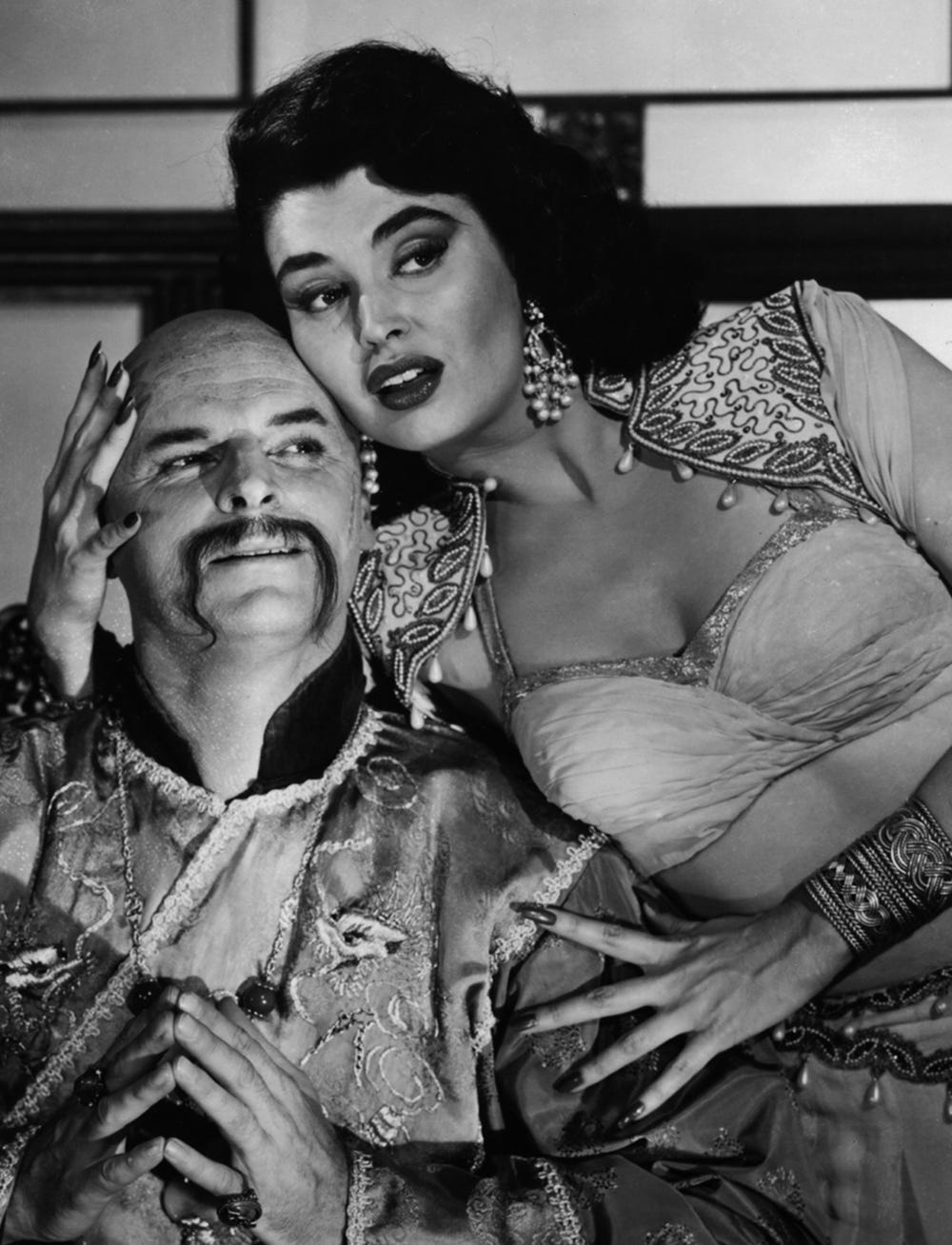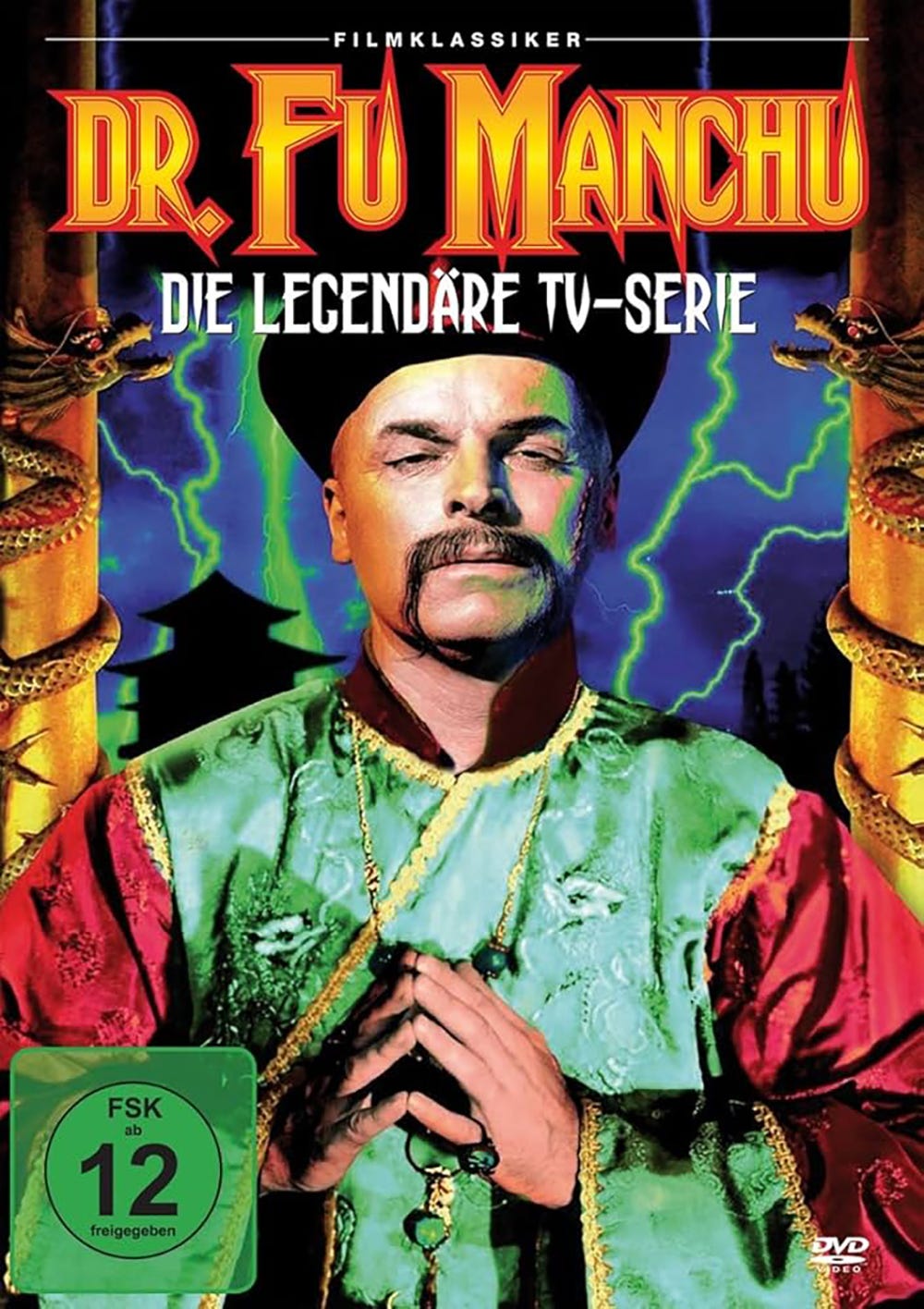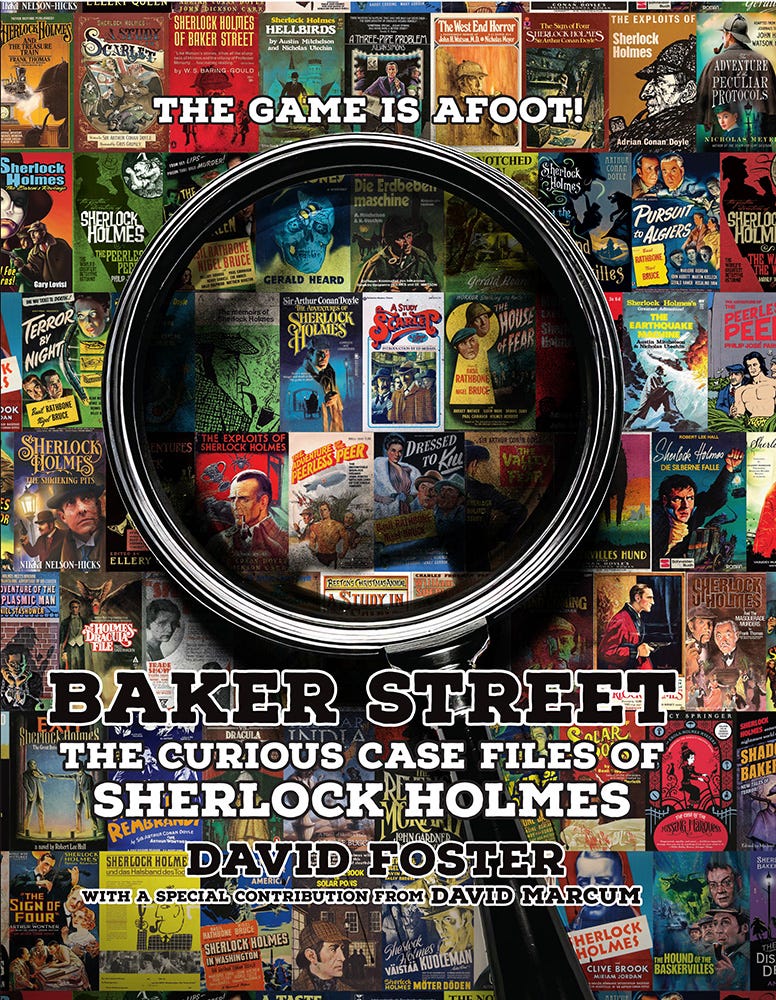Broadcasting Evil: The Bizarre Television Legacy of Dr. Fu Manchu
Beyond Baker Street VI: David Foster Unpacks the Devil Doctor’s Small-Screen Reign
In the sixth installment of Beyond Baker Street, author David Foster ventures into the strange and shadowy world of 1950s television, examining The Adventures of Fu Manchu—a short-lived series that blended Cold War fears, pulp tropes, and eyebrow-raising performances. From hypnotic nurses and global conspiracies to Hitler hiding out on a Pacific island, this serialized spectacle might be pulpy nonsense—but it’s never dull. Dive into a pop culture curiosity that reveals as much about its era as it does about the long cinematic shadow of Fu Manchu.
Beyond Baker Street VI
The Adventures of Fu Manchu
Fu Manchu on Television
G’day friends. Welcome to the third instalment of this series on the nefarious Doctor Fu Manchu. This time around, I’m turning my attention to the television series The Adventures of Fu Manchu. Read on, if you dare!
The Prisoner of Dr. Fu Manchu (1956) was the first of a thirteen-episode television series made be Studio City Television Productions, which was the television arm of Republic Pictures. The decision to make the serial was most probably based on the success of the Republic cliffhanger serial The Drums of Fu Manchu (1940), which is considered one of the greatest serials ever made. Incidentally, The Drums of Fu Manchu was edited down to 69 minutes and released as a movie in 1943. The co-director of The Drums of Fu Manchu, William Witney, also helmed (at least) seven episodes from this series.
Each episode starts with Fu Manchu playing a chess game with an unseen opponent. A voice over tells us:
Black and white. Life and death.
Good and evil. Two sides of a chess game.
Two forces in the universe
—one magnificent
—the other sinister.
It is said that the Devil plays for men’s souls. So does Dr. Fu Manchu.
—Satan himself
—evil incarnate!
As the story begins, a newspaper floats across the screen. The headline reads: “Professor Hugh Yan key to World Crisis.” Hugh Yan (Leonard Strong) is a special delegate to “The Conference of Nations” from an un-named Asian country. He flies from the east, stopping briefly in Hong Kong for the plane to refuel and for Yan to give an interview where he outlines his formula for World Peace. Then he continues his journey.
Then we’re introduced to the evil Dr. Fu Manchu. Glen Gordon plays the devil doctor and he’s clearly not Asian. In fact, it would appear that the whole cast is Caucasian with simple makeup effects to make them look Chinese.
Fu Manchu has two constant minions throughout the series. The first is a person with dwarfism named Kolb, played by John George. A quick glance at IMDb, it would appear that George had an amazing cinematic career, beginning in the silent era in 1916 and working through until his last appearance in Sinatra’s Ocean’s Eleven in 1960. All in all, he appeared in one hundred and thirty productions—but the truly staggering thing is he only received screen credit on a handful of occasions.
Fu Manchu’s other minion—or should I say concubine—is the gorgeous Karamaneh, played by Hawaiian beauty Laurette Luez. Luez’s alleged claim to fame is that she gave Norma Jean Baker her stage-acting name, which was Marilyn Monroe.
As we meet Fu Manchu and his minions, they’re hypnotising Betty Leonard (Carla Balenda). Betty is a nurse who works at the airport, checking tourists as they come through customs. Under hypnosis, Fu Manchu tells her that Hugh Yan will be arriving soon and suggests that he will have a rare tropical disease and only she can save his life. The serum she is told to use is hidden in her purse.
Sir Dennis Nayland Smith (Lester Matthews), late of Scotland yard, is the chief security officer at the Peace conference. He assigns his close friend, Dr. John Petrie (Clark Howat), to monitor the well being of the delegates as they arrive in the country.
Hugh Yan arrives, and under Fu Manchu’s hypnotic spell, Betty injects him with the serum provided by the devil doctor, but Dr. Petrie arrives in the nick of time before she can inject the full dose. But nonetheless, Yan slips into a coma and is taken to the hospital.
One thing about this incarnation of Fu Manchu is that he appears to have video cameras everywhere. He spends a large amount of time in front of the television watching his plans unfold, and as such always knows what is going on. Seeing that Betty has failed in his mission, Fu sends another minion to the hospital to kidnap Yan.
Nayland Smith believes Fu Manchu is behind Hugh Yan’s disappearance, and as such the whole peace conference is jeopardised. Events become even more tangled when Yan finally does turn up at the conference, partially paralysed after his ordeal. But this Yan is not the same beacon of hope and possibility. This Yan is full of mistrust and contempt.
At only twenty-five minutes each, and with each episode fairly self-contained, there is not much time for an overly convoluted plot or character development, and as such this series is a shallow time killer. At least the episodes are fast paced and have a certain amount of outlandish-—if not quite developed—plot situations. I would suggest that this series will offer very little to those who do not have an interest in the character Fu Manchu or vintage television.
The Death Ships of Fu Manchu (1956) is the ninth the episode in the Studio City Television series featuring the Devil Doctor, Fu Manchu. Traditionally, Fu Manchu’s nemesis is Dennis Nayland Smith of Scotland Yard. In the first episode of this series, when we are introduced to Nayland Smith, Dr. Petrie’s voice-over informs us that Nayland Smith is formally of Scotland Yard, meaning he doesn’t work for the “Yard” anymore. In this episode it’s explained that Nayland Smith is a British Secret Service operative, which makes sense of Nayland Smith’s globe-trotting ways. It would seem a bit silly for a Scotland Yard Inspector to be loitering around with his good friend Dr. Petrie in the United States, just waiting for an incident to happen. As an agent, he can be anywhere at any time.
In this instance, Nayland Smith (Lester Matthews) is currently in Hong Kong with Dr. Petrie (Clark Howat), and they’re checking all goods coming into the country from the United States. It appears somebody has broken into a research laboratory in California and stolen a deadly germ culture. It’s suspected that this lethal virus will be smuggled into Red China through Hong Kong.
It appears that the man behind the theft is Dr. Fu Manchu (Glen Gordon), and he has shipped two small boxes on the freighter Carfax, under the command of Captain Warren (Hugh Sanders). As the ship approaches Hong Kong, it is caught up in a wild storm and driven into the rocks. The captain gives the order to abandon ship. The captain, as he has been well-paid, collects the two small boxes and brings them with him on the lifeboat.
As the Carfax sank, and no cargo was put ashore in Hong Kong, Nayland Smith believes there is no cause for alarm on this occasion, but still is wary enough to choose to interview the crew members of the Carfax.
Meanwhile Fu Manchu, who is now also in Hong Kong, has received his boxes of deadly germ culture. Now he needs it shipped forward to the Red Chinese, and he believes that once again Captain Warren is the man to transfer the merchandise. However, Nayland Smith finds it strange that a man who just lost a ship in a storm should so quickly be given a new ship to command. He chooses to investigate further.
The Death Ships of Dr. Fu Manchu still seems topical today, even sixty years after it was first broadcast. It has a strange duality to it. The Red Chinese must not get their hands on the American germ culture because they will use it on their own people and hold the Americans responsible. With the Americans then being blamed for releasing germ warfare in China, China can then, in the eyes of the world, justifiably retaliate. But before you condemn the Chinese, you’ve got to ask why the Americans were experimenting with deadly germs cultures in the first place.
At the end of the day, though, the plot contrivances and the politics of the day are simply there to drive the plot along as fast as possible. The Fu Manchu series, like wartime propaganda films, are products of their time and place.
The Master Plan of Dr. Fu Manchu (1956). Television has come a long way, and this episode of The Adventures of Fu Manchu is pretty hard going. Most of this is primarily to do with Glen Gordon as Fu Manchu. He isn’t charismatic, and his clipped quasi-Chinese delivery is dire. At least this episode has a pretty wild premise for the plot—that Adolph Hitler did not die at the end of the War in Europe and has been living on an unchartered island in the Pacific. That is, until now. He has teamed up with the Devil Doctor, and together they plan to rule the world [insert evil maniacal laughter fading into the distance].
As this, the eleventh episode in the series, opens, Fu Manchu is watching some film footage of Hitler and the Nazi war machine in action. He’s impressed. He immediately sends out one of his minions to kidnap Dr. Harlow Henderson (Alan Dexter), who’s a world-renowned plastic surgeon.
Henderson is brought before Fu Manchu and forced to alter the features of Adolph Hitler. Henderson’s disappearance doesn’t go unnoticed, and his secretary, Betty Leonard (Carla Balenda), contacts Dr. Petrie (Clark Howat). Petrie, without the aid of his good friend Nayland Smith, goes to investigate. From an indentation on a notepad—you know where they rub a pencil over the page to see what had been written on the top sheet—Petrie discovers where Henderson went, but he too is caught and brought before the evil doctor. This doesn’t bode well for Henderson. With two doctors on the scene, he is no longer required. It is Henderson rather than Petrie, because Henderson knows too much, and can identify the altered Fuehrer. To Petrie, Hitler is just a man swathed in bandages—he has no idea of what’s going on.
Henderson is killed and his body is dumped in a river, but Fu Manchu’s minions are seen by the police in the act. Henderson’s body is soon recovered, and an autopsy report shows that he died from the venom of a rare spider (Tarantula Maximus). This tiny piece of information alerts Nayland Smith to the involvement of the most evil man alive, Fu Manchu.
Nayland Smith takes on the case, attempting to track down his friend Dr. Petrie, the evil Fu Manchu, and a bandaged madman who has a new plan to take over the world.
This episode may be silly far-fetched pulpy nonsense, but really, I wouldn’t have it any other way. I would like a bit more character development, but these episodes only go for around twenty-five minutes, so the time is spent delivering fast paced thrills.
“You can read my thoughts on when Sherlock Holmes met Fu Manchu in Cay Van Ash’s Ten Years Beyond Baker Street in 52 Weeks, 52 Sherlock Holmes Novels— a multi-personal look at fifty-two of the best Sherlockian pastiches—edited and collated by Paul Bishop.”
Beyond Baker Street
I’ve always been fascinated by the shadow cast by Sherlock Holmes—a figure so iconic that his influence seeps into unexpected corners of pop culture. Beyond Baker Street is where I chase those echoes. Whether it’s a villain who once faced Holmes or a story that feels like it should’ve, this series lets me explore the strange tributaries that flow from the great detective’s world.
If you’ve enjoyed this piece, you’ll find even more to explore in my book Baker Street: The Curious Case Files of Sherlock Holmes—a deep dive into 100+ years of Sherlock Holmes in print, film, television, and beyond. From Conan Doyle’s original stories to pastiches, parodies, and pop culture echoes, it’s a must-read for Holmes fans and curious minds alike.
Yours in the Spirit of Adventure
David Foster is an Australian best-selling author who writes under the pen names James Hopwood, A.W. Hart, and Jack Tunney. Under the latter, he has contributed three titles to the popular Fight Card series. His short fiction has been published in over 50 publications worldwide, including by Clan Destine Press, Wolfpack Publishing, and Pro Se Productions, to name but a few. In 2015, he contributed to the multi-award-winning anthology Legends of New Pulp Fiction, published by Airship 27 Publishing.
Foster’s non-fiction work appeared in the award-winning Crime Factory Magazine, as well as contributing numerous articles exploring pulp fiction in popular culture to Girl Gangs, Biker Boys, and Real Cool Cats: Pulp Fiction and Youth Culture, 1950 to 1980 (2017, PM Press) and Sticking It to The Man: Revolution and Counterculture in Pulp and Popular Fiction, 1950 to 1980 (2019, PM Press). He has also contributed articles on the ANZAC war experience to Remembrance (2024, Union Street 21).
Foster lives in the old Pentridge Prison Complex, behind high grey stone walls, in inner-suburban Melbourne, Australia.







